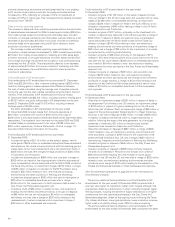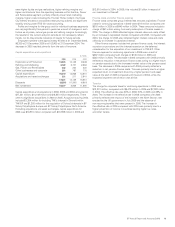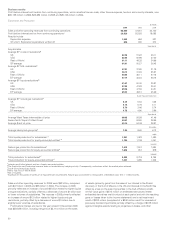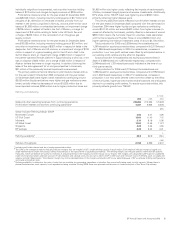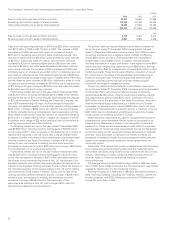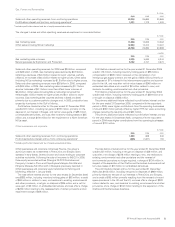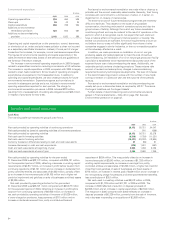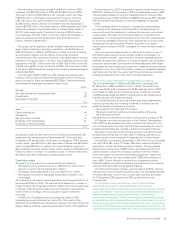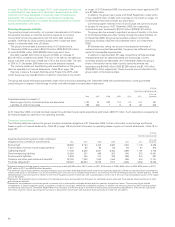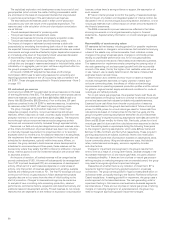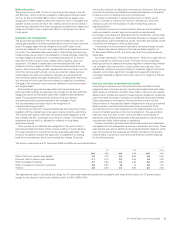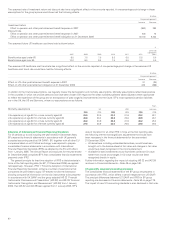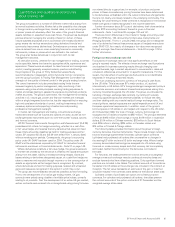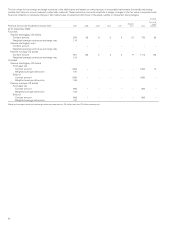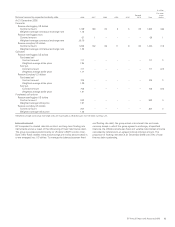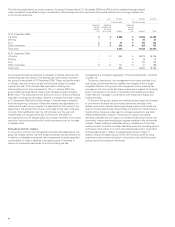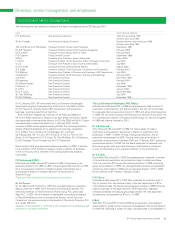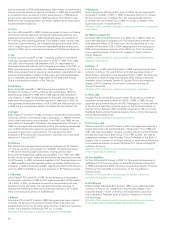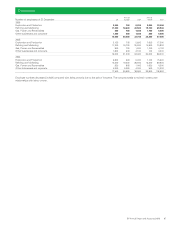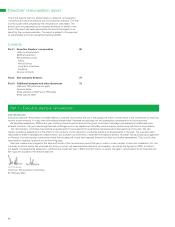BP 2006 Annual Report Download - page 60
Download and view the complete annual report
Please find page 60 of the 2006 BP annual report below. You can navigate through the pages in the report by either clicking on the pages listed below, or by using the keyword search tool below to find specific information within the annual report.The capitalized exploration and development costs for proved oil and
gas properties (which include the costs of drilling unsuccessful wells)
are amortized on the basis of oil-equivalent barrels that are produced
in a period as a percentage of the estimated proved reserves.
The estimated proved reserves used in these unit-of-production
calculations vary with the nature of the capitalized expenditure. The
reserves used in the calculation of the unit-of-production amortization
are as follows:
– Proved developed reserves for producing wells.
– Total proved reserves for development costs.
– Total proved reserves for licence and property acquisition costs.
– Total proved reserves for future decommissioning costs.
The impact of changes in estimated proved reserves is dealt with
prospectively by amortizing the remaining book value of the asset over
the expected future production. If proved reserves estimates are revised
downwards, earnings could be affected by higher depreciation expense or
an immediate write-down of the property’s book value (see discussion
of recoverability of asset carrying values below).
Given the large number of producing fields in the group’s portfolio, it is
unlikely that any changes in reserves estimates for individual fields, either
individually or in aggregate, year on year, will have a significant effect on
the group’s prospective charges for depreciation.
At the end of 2006, BP adopted the Securities and Exchange
Commission (SEC) rules for estimating reserves for accounting and
reporting purposes instead of the UK accounting rules contained in the
UK SORP. These changes are explained in Financial statements – Note 3
on page 110.
Oil and natural gas reserves
Commencing in 2006, BP has estimated its proved reserves on the basis
of the requirements of the SEC. The 2006 year-end marker prices used to
determine reserves volumes were Brent $58.93/bbl ($58.21/bbl) and
Henry Hub $5.52/mmBtu ($9.52/mmbtu). Prior to this date, BP used
guidance contained in the UK SORP to estimate reserves. In estimating
its reserves under UK SORP, BP used long-term planning prices.
The group manages its hydrocarbon resources in three major
categories: prospect inventory, non-proved resources and proved
reserves. When a discovery is made, volumes usually transfer from the
prospect inventory to the non-proved resource category. The resources
move through various non-proved resource sub-categories as their
technical and commercial maturity increases through appraisal activity.
Resources in a field will only be categorized as proved reserves when
all the criteria for attribution of proved status have been met, including
an internally imposed requirement for project sanction or for sanction
expected within six months and, for additional reserves in existing fields,
the requirement that the reserves be included in the business plan and
scheduled for development, typically within three years. Where, on
occasion, the group decides to book reserves where development is
scheduled to commence beyond three years, these reserves will be
booked only where they satisfy the SEC’s criteria for attribution of proved
status. Internal approval and final investment decision are what we refer
to as project sanction.
At the point of sanction, all booked reserves will be categorized as
proved undeveloped (PUD). Volumes will subsequently be recategorized
from PUD to proved developed (PD) as a consequence of development
activity. When part of a well’s reserves depends on a later phase of
activity, only that portion of reserves associated with existing, available
facilities and infrastructure moves to PD. The first PD bookings will occur
at the point of first oil or gas production. Major development projects
typically take one to four years from the time of initial booking to the
start of production. Changes to reserves bookings may be made due
to analysis of new or existing data concerning production, reservoir
performance, commercial factors, acquisition and divestment activity and
additional reservoir development activity. Proved reserves do not include
reserves that are dependent on the renewal of exploration and production
licences, unless there is strong evidence to support the assumption of
such renewal.
BP has an internal process to control the quality of reserves bookings
that forms part of a holistic and integrated system of internal control. As
discussed in the oil and natural gas accounting section and below, oil and
natural gas reserves have a direct impact on certain amounts reported in
the financial statements.
The 2006 movements in proved reserves are reflected in the tables
showing movements in oil and gas reserves by region in Financial
statements – Supplementary information on oil and natural gas on pages
196-197.
Recoverability of asset carrying values
BP assesses its fixed assets, including goodwill, for possible impairment
if there are events or changes in circumstances that indicate that carrying
values of the assets may not be recoverable. Such indicators include
changes in the group’s business plans, changes in commodity prices
leading to unprofitable performance and, for oil and gas properties,
significant downward revisions of estimated proved reserves quantities.
The assessment for impairment entails comparing the carrying value of
the cash generating unit and associated goodwill with the recoverable
amount of the asset, that is, the higher of net realizable value and value
in use. Value in use is usually determined on the basis of discounted
estimated future net cash flows.
Determination as to whether and how much an asset is impaired
involves management estimates on highly uncertain matters such
as future commodity prices, the effects of inflation and technology
improvements on operating expenses, production profiles and the outlook
for global or regional market supply-and-demand conditions for crude oil,
natural gas and refined products.
For oil and natural gas properties, the expected future cash flows are
estimated based on the group’s plans to continue to develop and produce
proved and associated risk-adjusted probable and possible reserves.
Expected future cash flows from the sale or production of reserves
are calculated based on the group’s best estimate of future oil and gas
prices. For 2006, prices for oil and natural gas used for future cash flow
calculations are based on market prices for the first five years and the
group’s long-term planning assumptions thereafter. As at 31 December
2006, the group’s long-term planning assumptions were $40 per barrel for
Brent and $5.50 per mmBtu for Henry Hub. Previously, prices for oil and
natural gas used in future cash flow calculations were assumed to decline
from the existing levels in equal steps during the following three years
to the long-term planning assumptions, which were $25 per barrel and
$4.0 per mmBtu for Brent and Henry Hub respectively. These long-term
planning assumptions are subject to periodic review and modification.
The estimated future level of production is based on assumptions about
future commodity prices, lifting and development costs, field decline
rates, market demand and supply, economic regulatory climates
and other factors.
Charges for impairment are recognized in the group’s results from
time to time as a result of, among other factors, adverse changes in the
recoverable reserves from oil and natural gas fields, low plant utilization
or reduced profitability. If there are low oil prices or natural gas prices or
refining margins or marketing margins over an extended period, the group
may need to recognize significant impairment charges.
Irrespective of whether there is any indication of impairment, BP is
required to test for impairment any goodwill acquired in a business
combination. The group carries goodwill of approximately $10.8 billion on
its balance sheet, principally relating to the Atlantic Richfield and Burmah
Castrol acquisitions. In testing goodwill for impairment, the group uses a
similar approach to that described above. The cash-generating units for
impairment testing in this case are one level below business segments.
As noted above, if there are low oil prices or natural gas prices or refining
margins or marketing margins for an extended period, the group may
need to recognize significant goodwill impairment charges.
58


